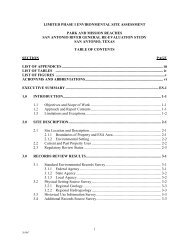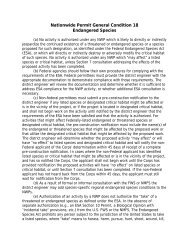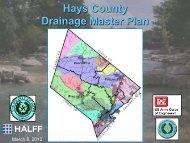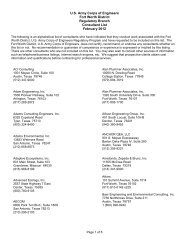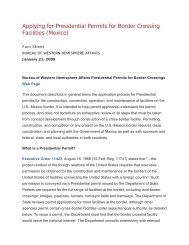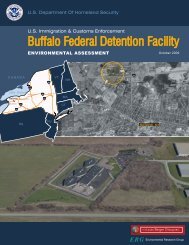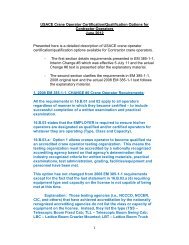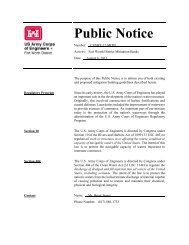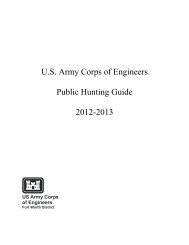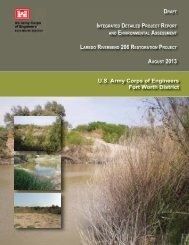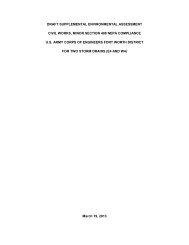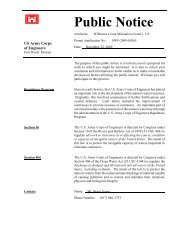environmental assessment us border patrol, tucson sector
environmental assessment us border patrol, tucson sector
environmental assessment us border patrol, tucson sector
Create successful ePaper yourself
Turn your PDF publications into a flip-book with our unique Google optimized e-Paper software.
Construction Fugitive D<strong>us</strong>t Emission FactorsGeneral Construction Activities Emission Factor0.19 ton PM10/acre-month Source: MRI 1996; EPA 2001; EPA 2006The area-based emission factor for construction activities is based on a study completed by the Midwest Research Institute (MRI) Improvement of Specific Emission Factors (BACM Project No.1), March 29, 1996. The MRI study evaluated seven construction projects in Nevada and California (Las Vegas, Coachella Valley, South Coast Air Basin, and the San Joaquin Valley). Thestudy determined an average emission factor of 0.11 ton PM10/acre-month for sites without large-scale cut/fill operations. A worst-case emission factor of 0.42 ton PM10/acre-month wascalculated for sites with active large-scale earth moving operations. The monthly emission factors are based on 168 work-hours per month (MRI 1996). A subsequent MRI Report in 1999,Estimating Particulate Matter Emissions from Construction Operations, calculated the 0.19 ton PM10/acre-month emission factor by applying 25% of the large-scale earthmoving emission factor(0.42 ton PM10/acre-month) and 75% of the average emission factor (0.11 ton PM10/acre-month).The 0.19 ton PM10/acre-month emission factor is referenced by the EPA for non-residential construction activities in recent procedures documents for the National Emission Inventory (EPA2001; EPA 2006). The 0.19 ton PM10/acre-month emission factor represents a refinement of EPA's original AP-42 area-based total s<strong>us</strong>pended particle (TSP) emission factor in Section 13.2.3Heavy Construction Operations. In addition to the EPA, this methodology is also supported by the South Coast Air Quality Management District and the Western Regional Air Partnership(WRAP) which is funded by the EPA and is administered jointly by the Western Governor's Association and the National Tribal Environmental Council. The emission factor is assumed toencompass a variety of non-residential construction activities including building construction (commercial, ind<strong>us</strong>trial, institutional, governmental), public works, and travel on unpaved roads. TheEPA National Emission Inventory documentation assumes that the emission factors are uncontrolled and recommends a control efficiency of 50% for PM10 and PM2.5 in PM nonattainmentareas.New Road Construction Emission Factor0.42 ton PM10/acre-month Source: MRI 1996; EPA 2001; EPA 2006The emission factor for new road construction is based on the worst-case conditions emission factor from the MRI 1996 study described above (0.42 tons PM10/acre-month). It is assumed thatroad construction involves extensive earthmoving and heavy construction vehicle travel resulting in emissions that are higher than other general construction projects. The 0.42 ton PM10/acremonthemission factor for road construction is referenced in recent procedures documents for the EPA National Emission Inventory (EPA 2001; EPA 2006).PM2.5 Multiplier 0.10PM2.5 emissions are estimated by applying a particle size multiplier of 0.10 to PM10 emissions. This methodology is consistent with the procedures documents for the National EmissionInventory (EPA 2006).Control Efficiency for PM10 and PM2.5 0.50The EPA National Emission Inventory documentation recommends a control efficiency of 50% for PM10 and PM2.5 in PM nonattainment areas. Wetting controls will be applied during projectconstruction (EPA 2006).References:EPA 2001. Procedures Document for National Emissions Inventory, Criteria Air Pollutants, 1985-1999. EPA-454/R-01-006. Office of Air Quality Planning and Standards, United StatesEnvironmental Protection Agency. March 2001.EPA 2006. Documentation for the Final 2002 Nonpoint Sector (Feb 06 version) National Emission Inventory for Criteria and Hazardo<strong>us</strong> Air Pollutants. Prepared for: Emissions Inventory andAnalysis Group (C339-02) Air Quality Assessment Division Office of Air Quality Planning and Standards, United States Environmental Protection Agency. July 2006.MRI 1996. Improvement of Specific Emission Factors (BACM Project No. 1). Midwest Research Institute (MRI). Prepared for the California South Coast Air Quality Management District, March29, 1996.



